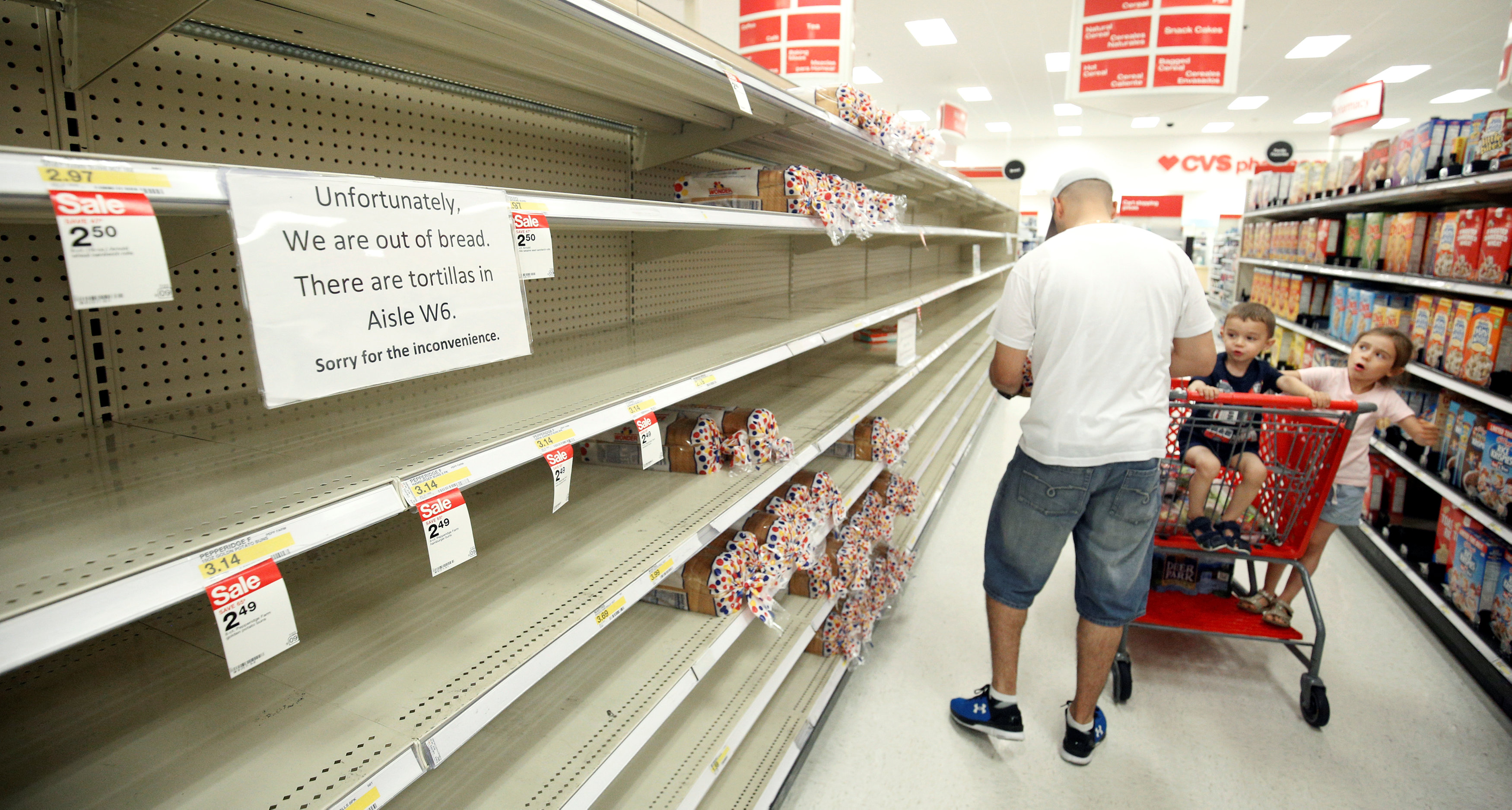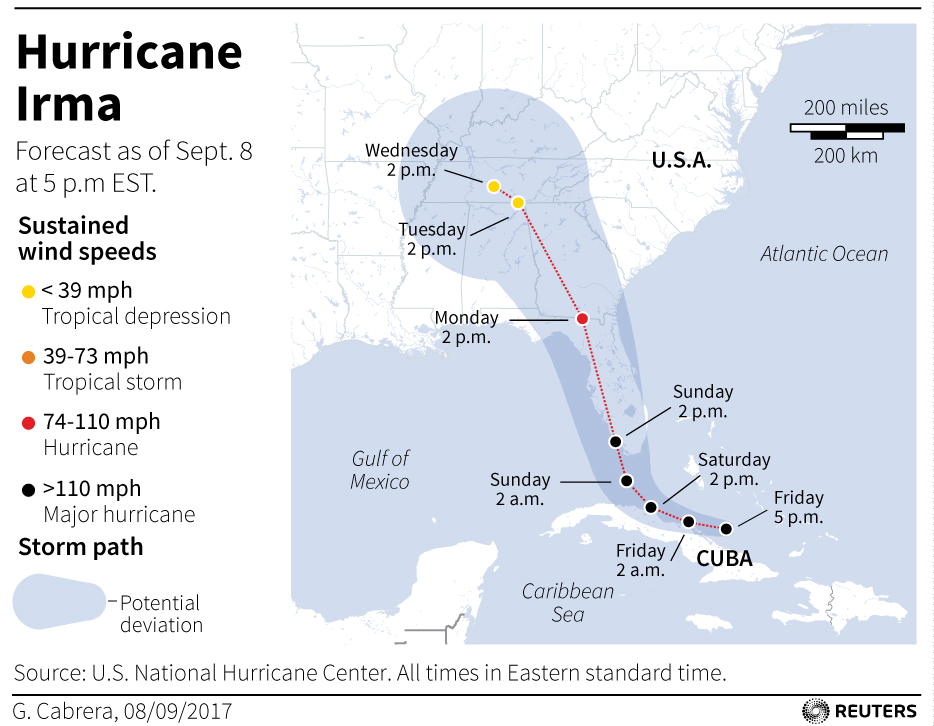By Marc Frank
HAVANA (Reuters) – Hurricane Irma weakened slightly on Saturday as it battered Cuba’s northern coast while millions of Florida residents were told to evacuate after the storm killed 21 people in the eastern Caribbean and left devastation in its wake.
Downgraded as a Category 4 storm, Irma moved along the Camaguey Archipelago with 155 mph (250 kph) winds early on Saturday, the U.S. National Hurricane Center (NHC) said. It has shifted between the Category 4 and Category 5 classification, which is used for the most powerful storms.
Irma, one of the fiercest Atlantic storms in a century, was expected to hit Florida early on Sunday, causing major damage due to high winds and flooding to the fourth-largest U.S. state by population.
The scenes of destruction along Cuba’s north central coast were similar to those seen in other Caribbean islands over the last week as Irma barreled in for a direct hit at Ciego de Avila province around midnight.
Choppy seas, gray skies, sheets of rain, bending palm trees, huge waves crashing over sea walls and downed power lines filled state-run television’s evening news bulletin.
Irma was forecast to bring dangerous storm surges of up to 6 feet (two meters) to parts of the island’s northern coast and the central and northwestern Bahamas.
Meteorologists warned that by early Saturday far greater devastation was sure to be caused as Irma moved westward through Sancti Spiritus and Villa Clara provinces where it is forecast to turn north toward Florida.
Irma was about 245 miles (395 km) south-southeast of Miami, the NHC said in its latest advisory.

Shoppers encounter empty bread shelves ahead of the arrival of Hurricane Irma at a supermarket in Kissimmee, Florida, U.S. September 8, 2017. REUTERS/Gregg Newton
“RUNNING OUT OF TIME”
With the storm barreling toward the United States, officials in Florida ordered an unprecedented evacuation, racing to overcome clogged highways, gasoline shortages and move elderly residents to safety.
“We are running out of time. If you are in an evacuation zone, you need to go now. This is a catastrophic storm like our state has never seen,” Governor Rick Scott told reporters.
A total of 5.6 million people, or 25 percent of the state’s population, were ordered to evacuate Florida, according to the Florida Division of Emergency Management.
The United States has been hit by only three Category 5 storms since 1851, and Irma is far larger than the last one in 1992, Hurricane Andrew, according to the Federal Emergency Management Agency (FEMA).
President Donald Trump said in a videotaped statement that Irma was “a storm of absolutely historic destructive potential” and called on people to heed recommendations from government officials and law enforcement. In Palm Beach, Trump’s waterfront Mar-a-Lago estate was ordered evacuated.
MANDATORY EVACUATIONS, GAS SHORTAGES
Irma was set to hit the United States two weeks after Hurricane Harvey, a Category 4 storm, struck Texas, killing about 60 people and causing property damage estimated at up to $180 billion in Texas and Louisiana. Officials were preparing a massive response, the head of FEMA said.
About nine million people in Florida may lose power, some for weeks, said Florida Power & Light Co, which serves almost half of the state’s 20.6 million residents.
Amid the exodus, nearly one-third of all gas stations in Florida’s metropolitan areas were out of gasoline, with scattered outages in Georgia, North Carolina and South Carolina, according to Gasbuddy.com, a retail fuel price tracking service.
Mandatory evacuations on Georgia’s Atlantic coast and some of South Carolina’s barrier islands were due to begin on Saturday. Virginia and Alabama were under states of emergency.
The governors of North and South Carolina warned residents to remain on guard even as the storm took a more westward track, saying their states still could experience severe weather, including heavy rain and flash flooding, early next week.
As it roared in from the east, Irma ravaged small islands in the northeastern Caribbean, including Barbuda, St. Martin and the British and U.S. Virgin Islands, flattening homes and hospitals and ripping down trees.
But even as they came to grips with the destruction, residents of the islands faced the threat of another major storm, Hurricane Jose.
Jose, expected to reach the northeastern Caribbean on Saturday, is an extremely dangerous storm nearing Category 5 status, with winds of up to 150 mph (240 kph), the NHC said.
(For a graphic on how Irma compares to other major hurricanes, click http://tmsnrt.rs/2gTxfqJ)
(Additional reporting by Makini Brice in Cap-Haitien, Haiti,; Delana Isles in Providenciales, Turks and Caicos, Sarah Marsh in Caibarien, Cuba, Bernie Woodall in Ft. Lauderdale, Florida, Ben Gruber and Andy Sullivan in Miami, Bate Felix, Richard Lough and Dominique Vidalon in Paris, Toby Sterling in Amsterdam and Neil Hartnell in Nassau, Bahamas; Writing by Brendan O’Brien in Milwaukee; Editing by Helen Popper)
 Hurricane Irma is driving toward Florida passing the eastern end of Cuba in this NASA's GOES-16 satellite image taken at about 0800 EDT on September 8, 2017. Courtesy NOAA National Weather Service National Hurricane Center/Handout via REUTERS
Hurricane Irma is driving toward Florida passing the eastern end of Cuba in this NASA's GOES-16 satellite image taken at about 0800 EDT on September 8, 2017. Courtesy NOAA National Weather Service National Hurricane Center/Handout via REUTERS

